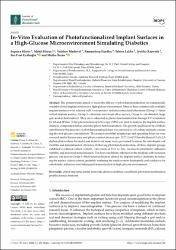| dc.contributor.author | Kheur, Supriya | |
| dc.contributor.author | Kheur, Mohit | |
| dc.contributor.author | Madiwal, Vaibhav | |
| dc.contributor.author | Sandhu, Ramandeep | |
| dc.contributor.author | Lakha, Tabrez | |
| dc.contributor.author | Rajwade, Jyutika | |
| dc.contributor.author | Eyüboğlu, Tan Fırat | |
| dc.contributor.author | Özcan, Mutlu | |
| dc.date.accessioned | 2023-04-07T12:06:19Z | |
| dc.date.available | 2023-04-07T12:06:19Z | |
| dc.date.issued | 2023 | en_US |
| dc.identifier.citation | Kheur, S., Kheur, M., Madiwal, V., Sandhu, R., Lakha, T., Rajwade, J. ... Özcan, M. (2023). In-vitro evaluation of photofunctionalized implant surfaces in a high-glucose microenvironment simulating diabetics. Journal of Functional Biomaterials, 14(3). https://dx.doi.org/10.3390/jfb14030130 | en_US |
| dc.identifier.issn | 2079-4983 | |
| dc.identifier.uri | https://dx.doi.org/10.3390/jfb14030130 | |
| dc.identifier.uri | https://hdl.handle.net/20.500.12511/10826 | |
| dc.description.abstract | The present study aimed to assess the efficacy of photofunctionalization on commercially available dental implant surfaces in a high-glucose environment. Discs of three commercially available implant surfaces were selected with various nano- and microstructural alterations (Group 1—laser-etched implant surface, Group 2—titanium–zirconium alloy surface, Group 3—air-abraded, large grit, acid-etched surface). They were subjected to photo-functionalization through UV irradiation for 60 and 90 min. X-ray photoelectron spectroscopy (XPS) was used to analyze the implant surface chemical composition before and after photo-functionalization. The growth and bioactivity of MG63 osteoblasts in the presence of photofunctionalized discs was assessed in cell culture medium containing elevated glucose concentration. The normal osteoblast morphology and spreading behavior were assessed under fluorescence and phase-contrast microscope. MTT (3-(4,5 Dimethylthiazol-2-yl)-2,5-diphenyltetrazolium bromide) and alizarin red assay were performed to assess the osteoblastic cell viability and mineralization efficiency. Following photofunctionalization, all three implant groups exhibited a reduced carbon content, conversion of Ti4+ to Ti3+, increased osteoblastic adhesion, viability, and increased mineralization. The best osteoblastic adhesion in the medium with increased glucose was seen in Group 3. Photofunctionalization altered the implant surface chemistry by reducing the surface carbon content, probably rendering the surfaces more hydrophilic and conducive for osteoblastic adherence and subsequent mineralization in high-glucose environment. | en_US |
| dc.description.sponsorship | International Team for Implantology | en_US |
| dc.language.iso | eng | en_US |
| dc.publisher | MDPI | en_US |
| dc.rights | info:eu-repo/semantics/openAccess | en_US |
| dc.rights | Attribution 4.0 International | * |
| dc.rights.uri | https://creativecommons.org/licenses/by/4.0/ | * |
| dc.subject | Dental Implants | en_US |
| dc.subject | Dental Materials | en_US |
| dc.subject | Diabetes Mellitus | en_US |
| dc.subject | Osteoblasts | en_US |
| dc.subject | Photofunctionalization | en_US |
| dc.subject | Prosthodontics | en_US |
| dc.subject | Titanium | en_US |
| dc.title | In-vitro evaluation of photofunctionalized implant surfaces in a high-glucose microenvironment simulating diabetics | en_US |
| dc.type | article | en_US |
| dc.relation.ispartof | Journal of Functional Biomaterials | en_US |
| dc.department | İstanbul Medipol Üniversitesi, Diş Hekimliği Fakültesi, Endodonti Ana Bilim Dalı | en_US |
| dc.authorid | 0000-0002-0308-9579 | en_US |
| dc.identifier.volume | 14 | en_US |
| dc.identifier.issue | 3 | en_US |
| dc.relation.publicationcategory | Makale - Uluslararası Hakemli Dergi - Kurum Öğretim Elemanı | en_US |
| dc.identifier.doi | 10.3390/jfb14030130 | en_US |
| dc.institutionauthor | Eyüboğlu, Tan Fırat | |
| dc.identifier.wosquality | Q2 | en_US |
| dc.identifier.wos | 000955897100001 | en_US |
| dc.identifier.scopus | 2-s2.0-85151138024 | en_US |
| dc.identifier.pmid | 36976054 | en_US |
| dc.identifier.scopusquality | Q2 | en_US |



















